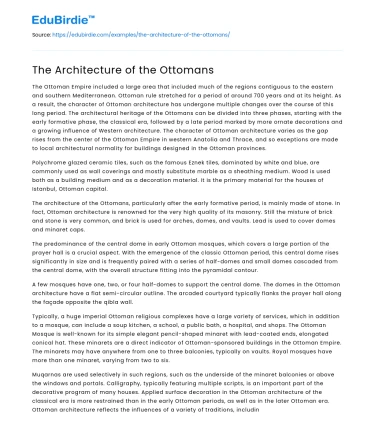The Ottoman Empire included a large area that included much of the regions contiguous to the eastern and southern Mediterranean. Ottoman rule stretched for a period of around 700 years and at its height. As a result, the character of Ottoman architecture has undergone multiple changes over the course of this long period. The architectural heritage of the Ottomans can be divided into three phases, starting with the early formative phase, the classical era, followed by a late period marked by more ornate decorations and a growing influence of Western architecture. The character of Ottoman architecture varies as the gap rises from the center of the Ottoman Empire in western Anatolia and Thrace, and so exceptions are made to local architectural normality for buildings designed in the Ottoman provinces.
Polychrome glazed ceramic tiles, such as the famous Eznek tiles, dominated by white and blue, are commonly used as wall coverings and mostly substitute marble as a sheathing medium. Wood is used both as a building medium and as a decoration material. It is the primary material for the houses of Istanbul, Ottoman capital.
Save your time!
We can take care of your essay
- Proper editing and formatting
- Free revision, title page, and bibliography
- Flexible prices and money-back guarantee
The architecture of the Ottomans, particularly after the early formative period, is mainly made of stone. In fact, Ottoman architecture is renowned for the very high quality of its masonry. Still the mixture of brick and stone is very common, and brick is used for arches, domes, and vaults. Lead is used to cover domes and minaret caps.
The predominance of the central dome in early Ottoman mosques, which covers a large portion of the prayer hall is a crucial aspect. With the emergence of the classic Ottoman period, this central dome rises significantly in size and is frequently paired with a series of half-domes and small domes cascaded from the central dome, with the overall structure fitting into the pyramidal contour.
A few mosques have one, two, or four half-domes to support the central dome. The domes in the Ottoman architecture have a flat semi-circular outline. The arcaded courtyard typically flanks the prayer hall along the façade opposite the qibla wall.
Typically, a huge imperial Ottoman religious complexes have a large variety of services, which in addition to a mosque, can include a soup kitchen, a school, a public bath, a hospital, and shops. The Ottoman Mosque is well-known for its simple elegant pencil-shaped minaret with lead-coated ends, elongated conical hat. These minarets are a direct indicator of Ottoman-sponsored buildings in the Ottoman Empire. The minarets may have anywhere from one to three balconies, typically on vaults. Royal mosques have more than one minaret, varying from two to six.
Muqarnas are used selectively in such regions, such as the underside of the minaret balconies or above the windows and portals. Calligraphy, typically featuring multiple scripts, is an important part of the decorative program of many houses. Applied surface decoration in the Ottoman architecture of the classical era is more restrained than in the early Ottoman periods, as well as in the later Ottoman era. Ottoman architecture reflects the influences of a variety of traditions, including those of the Anatolian Seljuqs and Byzantines, all of which prevailed in Anatolia before the Ottomans came to power. More precisely, the Imperial Ottoman Mosques of the Classical Era display the strong influence of the Byzantine church of Hagia Sophia in the mid-6th century AD.






 Stuck on your essay?
Stuck on your essay?

